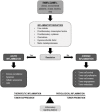Innate immunity and HPV: friends or foes
- PMID: 30328949
- PMCID: PMC6157093
- DOI: 10.6061/clinics/2018/e549s
Innate immunity and HPV: friends or foes
Abstract
Most human papillomavirus infections are readily cleared by the host immune response. However, in some individuals, human papillomavirus can establish a persistent infection. The persistence of high-risk human papillomavirus infection is the major risk factor for cervical cancer development. These viruses have developed mechanisms to evade the host immune system, which is an important step in persistence and, ultimately, in tumor development. Several cell types, receptors, transcription factors and inflammatory mediators involved in the antiviral immune response are viral targets and contribute to tumorigenesis. These targets include antigen-presenting cells, macrophages, natural killer cells, Toll-like receptors, nuclear factor kappa B and several cytokines and chemokines, such as interleukins, interferon and tumor necrosis factor. In the present review, we address both the main innate immune response mechanisms involved in HPV infection clearance and the viral strategies that promote viral persistence and may contribute to cancer development. Finally, we discuss the possibility of exploiting this knowledge to develop effective therapeutic strategies.
Conflict of interest statement
No potential conflict of interest was reported.
Figures
References
-
- Ferlay J, Soerjomataram I, Ervik M, Dikshit R, Eser S, Mathers C, et al. GLOBOCAN 2012 v1.0, Cancer Incidence and Mortality Worldwide: IARC CancerBase No. 11 [Internet] Lyon, France: International Agency for Research on Cancer; 2013. Available from: http://globocan.iarc.f.
MeSH terms
LinkOut - more resources
Full Text Sources
Medical


